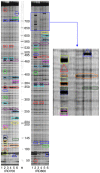High-throughput discovery of chloroplast and mitochondrial DNA polymorphisms in Brassicaceae species by ORG-EcoTILLING
- PMID: 23185237
- PMCID: PMC3504036
- DOI: 10.1371/journal.pone.0047284
High-throughput discovery of chloroplast and mitochondrial DNA polymorphisms in Brassicaceae species by ORG-EcoTILLING
Abstract
Background: Information on polymorphic DNA in organelle genomes is essential for evolutionary and ecological studies. However, it is challenging to perform high-throughput investigations of chloroplast and mitochondrial DNA polymorphisms. In recent years, EcoTILLING stands out as one of the most universal, low-cost, and high-throughput reverse genetic methods, and the identification of natural genetic variants can provide much information about gene function, association mapping and linkage disequilibrium analysis and species evolution. Until now, no report exists on whether this method is applicable to organelle genomes and to what extent it can be used.
Methodology/principal findings: To address this problem, we adapted the CEL I-based heteroduplex cleavage strategy used in Targeting Induced Local Lesions in Genomes (TILLING) for the discovery of nucleotide polymorphisms in organelle genomes. To assess the applicability and accuracy of this technology, designated ORG-EcoTILLING, at different taxonomic levels, we sampled two sets of taxa representing accessions from the Brassicaceae with three chloroplast genes (accD, matK and rbcL) and one mitochondrial gene (atp6). The method successfully detected nine, six and one mutation sites in the accD, matK and rbcL genes, respectively, in 96 Brassica accessions. These mutations were confirmed by DNA sequencing, with 100% accuracy at both inter- and intraspecific levels. We also detected 44 putative mutations in accD in 91 accessions from 45 species and 29 genera of seven tribes. Compared with DNA sequencing results, the false negative rate was 36%. However, 17 SNPs detected in atp6 were completely identical to the sequencing results.
Conclusions/significance: These results suggest that ORG-EcoTILLING is a powerful and cost-effective alternative method for high-throughput genome-wide assessment of inter- and intraspecific chloroplast and mitochondrial DNA polymorphisms. It will play an important role in evolutionary and ecological biology studies, in identification of related genes associated with agronomic importance such as high yield and improved cytoplasmic quality, and for identifying mitochondrial point mutations responsible for diseases in humans and other animals.
Conflict of interest statement
Figures








Similar articles
-
Chloroplast genomes of Rubiaceae: Comparative genomics and molecular phylogeny in subfamily Ixoroideae.PLoS One. 2020 Apr 30;15(4):e0232295. doi: 10.1371/journal.pone.0232295. eCollection 2020. PLoS One. 2020. PMID: 32353023 Free PMC article.
-
Efficient discovery of DNA polymorphisms in natural populations by Ecotilling.Plant J. 2004 Mar;37(5):778-86. doi: 10.1111/j.0960-7412.2003.01999.x. Plant J. 2004. PMID: 14871304
-
Evolution of organellar genomes.Curr Opin Genet Dev. 1999 Dec;9(6):678-87. doi: 10.1016/s0959-437x(99)00030-1. Curr Opin Genet Dev. 1999. PMID: 10607615 Review.
-
Double-strand break repair processes drive evolution of the mitochondrial genome in Arabidopsis.BMC Biol. 2011 Sep 27;9:64. doi: 10.1186/1741-7007-9-64. BMC Biol. 2011. PMID: 21951689 Free PMC article.
-
TILLING: a shortcut in functional genomics.J Appl Genet. 2011 Nov;52(4):371-90. doi: 10.1007/s13353-011-0061-1. Epub 2011 Sep 13. J Appl Genet. 2011. PMID: 21912935 Free PMC article. Review.
Cited by
-
Comprehensive Analysis of the COBRA-Like (COBL) Gene Family in Gossypium Identifies Two COBLs Potentially Associated with Fiber Quality.PLoS One. 2015 Dec 28;10(12):e0145725. doi: 10.1371/journal.pone.0145725. eCollection 2015. PLoS One. 2015. PMID: 26710066 Free PMC article.
-
High-throughput multiplex cpDNA resequencing clarifies the genetic diversity and genetic relationships among Brassica napus, Brassica rapa and Brassica oleracea.Plant Biotechnol J. 2016 Jan;14(1):409-18. doi: 10.1111/pbi.12395. Epub 2015 Jun 1. Plant Biotechnol J. 2016. PMID: 26031705 Free PMC article.
-
Plastome Mutations and Recombination Events in Barley Chloroplast Mutator Seedlings.J Hered. 2016 May;107(3):266-73. doi: 10.1093/jhered/esw003. Epub 2016 Jan 16. J Hered. 2016. PMID: 26774059 Free PMC article.
-
Genomics Armed With Diversity Leads the Way in Brassica Improvement in a Changing Global Environment.Front Genet. 2021 Feb 18;12:600789. doi: 10.3389/fgene.2021.600789. eCollection 2021. Front Genet. 2021. PMID: 33679880 Free PMC article. Review.
References
-
- Azam A, Paul J, Sehgal D, Prasad J, Bhattacharya S, et al. (1996) Identification of novel genes from Entamoeba histolytica by expressed sequence tag analysis. Gene 181: 113–116. - PubMed
-
- Féral J (2002) How useful are the genetic markers in attempts to understand and manage marine biodiversity? J Exp Mar Biol Ecol 268: 121–145.
-
- Liu Z, Cordes J (2004) DNA marker technologies and their applications in aquaculture genetics. Aquaculture 238: 1–37.
-
- Ryman N, Utter F (1987) Population genetics and fishery management. Seattle: University of Washington Press.
Publication types
MeSH terms
Substances
LinkOut - more resources
Full Text Sources
Miscellaneous

